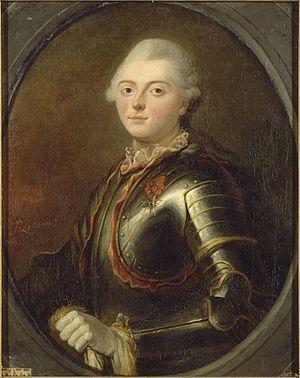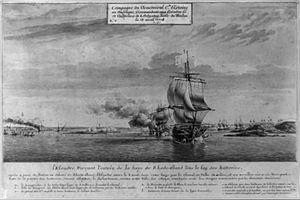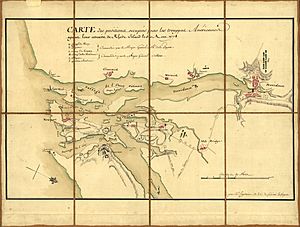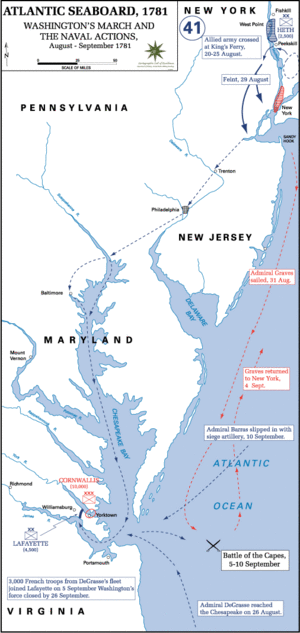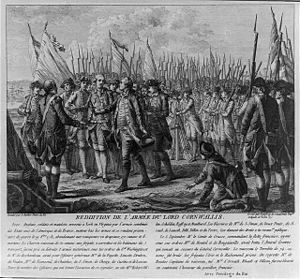Naval battles of the American Revolutionary War facts for kids
Quick facts for kids Naval battles of the American Revolutionary War |
|||||||
|---|---|---|---|---|---|---|---|
| Part of the American Revolutionary War | |||||||
 French and British ships battling on the Chesapeake, 3 September 1781 |
|||||||
|
|||||||
| Belligerents | |||||||
| Commanders and leaders | |||||||
The American Revolutionary War (1775-1783) involved many important battles at sea. The British Royal Navy fought against the new Continental Navy of the American colonies starting in 1775. Later, the French Navy joined the fight in 1778.
Even though the British often won more battles, these naval clashes were very important. They helped lead to the surrender of British General Charles Cornwallis at Yorktown. This big event directly led to peace talks and the end of the war.
At the start of the war, the British navy controlled the seas. They blocked major colonial ports and raided American towns along the coast. The American colonies had almost no navy, so they couldn't stop these attacks.
In 1777, American privateers (private ships allowed to attack enemy ships) began raiding British waters. They captured merchant ships and took them to French and Spanish ports. France and Spain were officially neutral then, but they secretly helped the Americans.
France wanted to challenge Britain's power. In February 1778, France signed two treaties with America. This meant France would help America, but they didn't declare war on Britain right away. The risk of a French invasion forced Britain to keep many ships in the English Channel. This left their forces in North America weaker and more open to attacks.
Contents
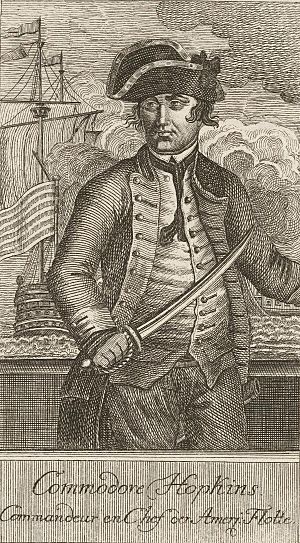
First Fights at Sea
When the Battles of Lexington and Concord happened in April 1775, thousands of American fighters surrounded British forces in Boston. The British were stuck in Boston, but they could still get supplies by sea. This was because the British navy controlled the harbor.
The American colonists had no warships at first. So, they couldn't stop British supply ships. However, supplies in Boston became very scarce and expensive. British Vice-Admiral Samuel Graves was in charge of the Royal Navy around Boston. He had stored important naval supplies and food on Noddle's Island.
The colonists started taking or destroying anything useful on Noddle's Island and Hog Island. Admiral Graves sent a British armed ship, Diana, to stop them. But the colonists fought back in the Battle of Chelsea Creek. They captured and burned Diana. This showed the British that the colonists could fight at sea.
Later, British ships were sent to get lumber from Machias. The people of Machias fought back and captured the British ship Margaretta. A local leader, Jeremiah O'Brien, then used this captured ship to create the first armed American vessel. He named it Machias Liberty. This area became a base for American privateers.
British Admiral Graves ordered attacks on coastal towns like Falmouth (now Portland). He burned Falmouth in October 1775. These attacks made the colonists very angry. This anger helped convince the Second Continental Congress to create the Continental Navy.
The US Navy officially began on October 13, 1775. On that day, Congress approved buying two armed ships. These ships became the Andrew Doria and the Cabot. The first ship to be ready for action was the Alfred. It was bought in November and ready in December.
The American army desperately needed gunpowder. So, Congress planned a naval mission to get military supplies from Nassau in the Bahamas. Esek Hopkins was chosen to lead this first fleet. His fleet included ships like the Alfred, Andrew Doria, and Providence. It also carried 200 marines.
In March 1776, Hopkins's fleet landed marines on New Providence island. They captured the town of Nassau and took military supplies. After loading the ships, the fleet sailed north.
On the way back, the fleet captured two British supply ships. But on April 6, they met the Glasgow, a strong British warship. In the Battle of Block Island, the Glasgow managed to escape. It damaged the American ship Cabot and hurt many sailors.
Even though they captured supplies, failing to capture the Glasgow caused problems for Hopkins. He was criticized for not following orders and for how he handled the captured goods. He was eventually removed from the Navy in 1778.
Meanwhile, on Lake Champlain, Benedict Arnold built 12 ships. These ships were meant to stop British forces from moving south. The British destroyed Arnold's fleet in the Battle of Valcour Island. But Arnold's actions slowed the British down enough until winter. This stopped them from capturing Fort Ticonderoga that year.
By 1781, most of the Continental Navy's ships were captured or sunk. But American privateers were very successful. They were private ships given permission to attack British merchant ships. They captured over 2,200 British ships. This caused a lot of financial damage to Britain.
France Joins the War: 1778–1780
French Fleet Arrives
In April 1778, France sent a large fleet to North America. It was led by Vice-Admiral Charles Henri Hector d'Estaing. He had 12 powerful warships and French soldiers. His orders were to block the British fleet in the Delaware River.
British leaders knew d'Estaing was coming. But arguments within the British government and navy delayed their response. So, d'Estaing sailed across the Atlantic without being stopped. He arrived in Delaware Bay in July.
However, the British had already moved their fleet from Philadelphia to New York City. So, d'Estaing sailed to New York. But New York's harbor was too well-defended for his large ships. So, the French decided to attack British-held Newport.
While d'Estaing was near New York, the British sent 2,000 soldiers to Newport. This increased the British forces there to over 6,700 men.
Newport Campaign and a Big Storm
On July 29, d'Estaing arrived off Newport. He met with American generals Nathanael Greene and Marquis de Lafayette. They planned a joint attack. American troops would attack from the east, and French troops from the west.
The British commander at Newport, General Pigot, prepared his defenses. He moved his troops and destroyed things that could help the French. French ships forced several British support ships to run aground. These were then burned to prevent capture.
On August 8, d'Estaing moved most of his fleet into Newport Harbor. The next day, he began landing his 4,000 troops on Conanicut Island. But then, American General John Sullivan learned that the British had left a key hill. Sullivan moved his troops to take the hill without telling d'Estaing first. This caused some tension between the allies.
Suddenly, British Admiral Lord Howe's fleet arrived. D'Estaing, worried that Howe would get more ships, quickly reboarded his troops. He sailed out on August 10 to fight Howe. But as the two fleets prepared, a huge storm hit. It lasted two days and scattered both fleets. Many ships were badly damaged, especially the French flagship.
The storm also ruined Sullivan's plans to attack Newport. The French fleet regrouped off Delaware. They returned to Newport on August 20. The British fleet went back to New York.
Despite American pleas, d'Estaing decided he couldn't help with the attack on Newport. His ships needed repairs, and his captains wanted to go to Boston. D'Estaing sailed for Boston on August 22.
French Leave Boston
The French decision to leave Newport made many Americans angry. General Sullivan used strong words, calling it "dishonorable to France." American soldiers felt the French had "deserted" them.
The French departure caused many American militia members to leave. General Sullivan learned that the British were sending more troops from New York. So, he decided to pull his forces back to the northern part of the island.
Meanwhile, Lord Howe tried to catch d'Estaing before he reached Boston. But d'Estaing held a strong position in Boston Harbor. Admiral John Byron, who took over from Howe, also failed to block d'Estaing. His fleet was scattered by another storm. D'Estaing then sailed away to the West Indies.
The British navy in New York was also active. Vice-Admiral Sir George Collier led raids on coastal towns. He also helped capture Stony Point on the Hudson River. But American forces later recaptured Stony Point in a surprise attack.
American morale was hurt later when they failed to work with the French to recapture Savannah. Savannah remained in British hands until 1782.
In April 1778, John Paul Jones led a raid on Whitehaven, England. This was the first time American forces attacked outside North America.
Yorktown Campaign
Planning for 1781
In 1781, French military leaders had to make big decisions. They knew they needed to help America more actively. They also had to work with Spain, who wanted to attack British Jamaica.
In March 1781, important plans were made. The French fleet in the West Indies, led by Admiral François Joseph Paul de Grasse, was ordered to go to Cap-Français (now Cap-Haïtien, Haiti). There, he would decide how to help Spanish operations. France also promised money to America instead of more troops.
The French army at Newport was ordered to join George Washington's army near New York. Admiral de Grasse was secretly told he could help in North America after his stop at Cap-Français.
First Moves in Virginia
In December 1780, British General Henry Clinton sent Benedict Arnold (who had switched sides) to Virginia. Arnold's troops raided and fortified Portsmouth. Washington sent Marquis de Lafayette to stop Arnold.
Washington asked the French fleet at Newport for help. The French commander, Admiral Chevalier Destouches, was blocked by a larger British fleet. So, he couldn't help at first.
In February, Destouches heard that British ships were damaged by a storm. He sent three French ships to Portsmouth. But Arnold's ships had shallower bottoms and could go up the Elizabeth River. The French ships were too big to follow.
On the way back, the French captured a British frigate, Romulus. This success, and Washington's requests, led Destouches to launch a bigger operation. On March 8, Destouches sailed with his whole fleet. He carried 1,200 troops to help in the Chesapeake.
British Admiral Mariot Arbuthnot knew Destouches was planning something. He chased the French fleet. Arbuthnot reached Cape Henry first on March 16. In the Battle of Cape Henry, Arbuthnot suffered a loss. But he still managed to get into Chesapeake Bay. This stopped the French from achieving their goal.
After delivering 2,000 more men to Arnold, Arbuthnot returned to New York. He resigned his post in July.
Fleets Arrive at Chesapeake
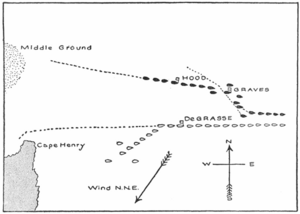
The main French fleet sailed from France on March 22. The British fleet was busy supplying Gibraltar, so they didn't stop them. Admiral de Grasse sent requests to America. He wanted to know the situation in North America. He also asked for 30 pilots who knew the American waters.
On May 21, Generals Washington and Rochambeau met. They discussed attacking either New York City or British forces in Virginia. Both options needed the French fleet from the West Indies. So, a ship was sent to de Grasse, asking for his help. Rochambeau secretly told de Grasse he preferred attacking Virginia.
De Grasse arrived at Cap-Français on August 15. He immediately sent word that he would go to the Chesapeake. He took 3,200 soldiers with him. He sailed with his entire fleet of 28 warships. He avoided normal shipping routes to stay hidden.
De Grasse arrived at the mouth of Chesapeake Bay on August 30. He landed his troops to help block Cornwallis on land. Two British frigates on patrol were trapped inside the bay. This meant the British in New York didn't know how strong de Grasse's fleet was until it was too late.
British Admiral George Rodney knew de Grasse might send some ships north. But he thought de Grasse would not take his whole fleet. So, Rodney divided his fleet. He sent Rear-Admiral Samuel Hood north with 15 ships. Rodney, who was sick, took the rest of his fleet back to Britain.
Hood's fleet arrived at the Chesapeake on August 25. He found no French ships. So, he sailed to New York to meet Admiral Thomas Graves. Graves had been trying to stop a French convoy bringing supplies to Boston.
When Hood arrived, Graves was in port. But he only had five ships ready for battle. News of the French fleet's movements made the British realize the Chesapeake was the target. On August 31, Graves sailed south with 19 ships.
He arrived at the Chesapeake on September 5. His progress was slow because some of his ships were in poor condition. The Battle of the Chesapeake began with a clash between the French ship Marseillois and the British ship Intrepid.
Aftermath
The British defeat at sea caused panic among British loyalists. The news was also very bad for leaders in London. King George III thought the British Empire was "ruined."
The French victory meant they completely controlled Chesapeake Bay. This allowed them to help transport Washington's and Rochambeau's forces to Yorktown.
It wasn't until September 23 that the British learned the French fleet in the Chesapeake had 36 ships. Cornwallis sent a message asking for help: "If you cannot relieve me very soon, you must be prepared to hear the worst."
Admiral Graves sailed from New York on October 19 with 25 ships and 7,000 troops. But it was too late. Two days earlier, Cornwallis had surrendered at Yorktown.
General Washington told de Grasse how important his role was. He said, "whatever efforts are made by the land armies, the navy must have the casting vote in the present contest." Cornwallis's surrender led to peace two years later. The Treaty of Paris in 1783 officially recognized the United States of America as an independent country.
Admiral de Grasse returned to the West Indies with his fleet. In 1782, he was defeated and captured by Rodney in the Battle of the Saintes. His flagship, Ville de Paris, was lost in a storm while being taken back to England.
See also
 In Spanish: Operaciones navales en la Guerra de Independencia de los Estados Unidos para niños
In Spanish: Operaciones navales en la Guerra de Independencia de los Estados Unidos para niños



